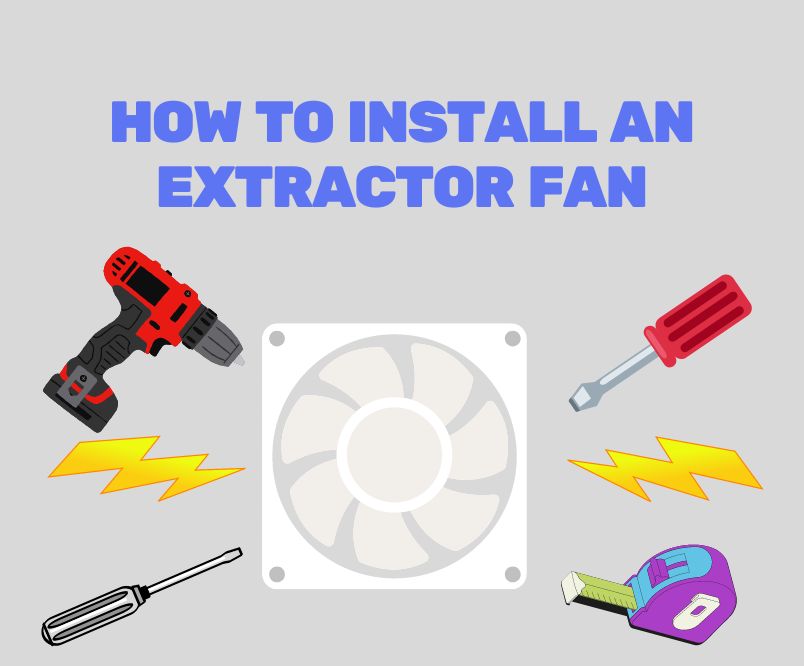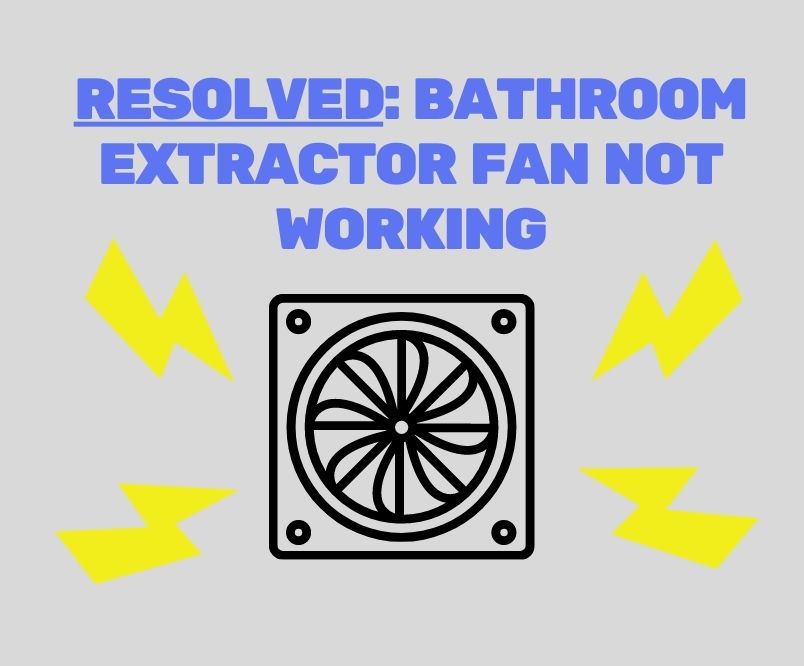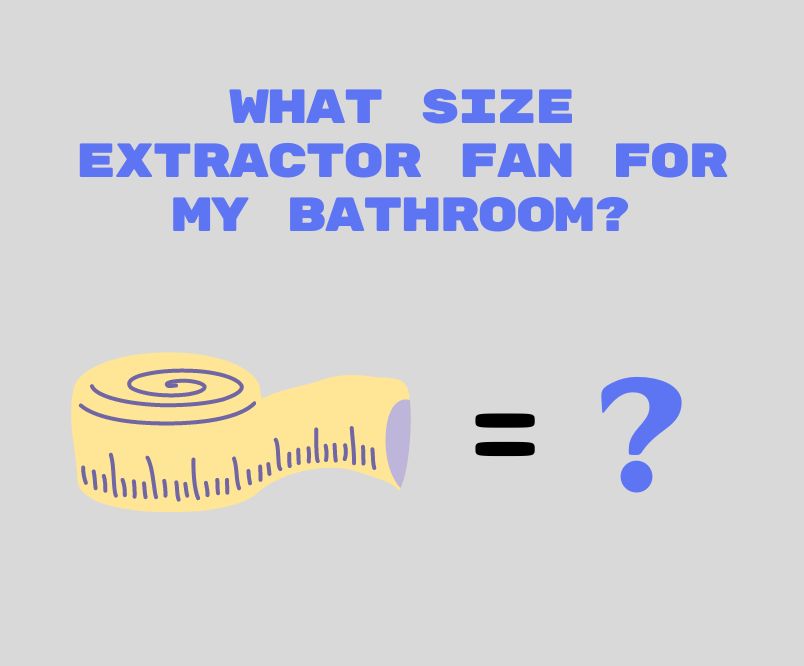How to Install an Extractor Fan?
Are you tired of having a stuffy bathroom after taking a hot shower?
An extractor fan could be the solution to your problem. But how do you install one?
Extractor fans are essential in homes to improve ventilation and prevent the buildup of moisture, which can cause mould and mildew.
However, many people are intimidated by the installation process and end up paying a professional to do it for them.
Installing an extractor fan is a simple and straightforward process that can be done by anyone with basic DIY skills.
In this article, we will guide you through the steps to install an extractor fan in your bathroom, saving you time and money.
So, let’s get started!
What is an Extractor Fan?
An extractor fan, also known as a ventilation fan, is a device used to remove stale air, moisture, and other impurities from a room or building.
It is typically installed in areas such as bathrooms, kitchens, and utility rooms where humidity and odours can accumulate.
The fan works by drawing air out of the space and venting it outside, either through a duct or directly through a wall or window.
Extractor fans can be operated manually or automatically, and are available in a range of sizes and styles to suit different applications.
They are an important component of any building’s ventilation system, helping to maintain indoor air quality and prevent the growth of mould and mildew.
Why is having an Extractor Fan important?
Having an extractor fan is important because it helps to remove excess moisture, unpleasant odours, and pollutants from indoor spaces.
In areas such as kitchens and bathrooms, where there is a lot of moisture and steam generated, extractor fans help to prevent the growth of mould and mildew, which can be harmful to health.
In addition, extractor fans can help to improve indoor air quality by removing smoke, dust, and other airborne pollutants.
This is particularly important for people who suffer from allergies or respiratory problems.
Overall, having an extractor fan is an important investment for maintaining a healthy and comfortable indoor environment.
What are the Laws and Regulations on Bathroom Ventilation?
The Building Regulations Document F includes regulations for how much ventilation your bathroom requires.
It is a very long document but the important points are as follows:
- To keep a UK bathroom fresh and healthy, it needs proper ventilation. You can do this by either having a window or an extractor fan.
- If your bathroom only has a toilet, a window will do.
- If you have a bath and a shower, you’ll need an extractor fan. This is because new builds are airtight, so natural ventilation is usually lower.
- For optimal results, aim for 15 litres per second or 54m3 per hour of ventilation in your bathroom.
What Size Extractor Fan Do I Need?
The size of the extractor fan you need will depend on the size of the room it will be installed in.
A general rule of thumb is that to calculate the size of the fan needed, measure the height, width and length of the room.
Once you have these figures then simply multiply them together, as follows:
For example, if you have a room that is 3m x 4m x 4m, the volume of the room is 48m.
You can then look for an extractor fan with a flow rate that matches or exceeds this figure.
It’s also important to consider the noise level of the fan and whether it is suitable for the intended use, such as a bathroom or kitchen.
To make it easier for you, we have created an extractor fan size calculator.
Extractor Fan Size Calculator
Your Results:
What are the Types of Extractor Fan?
There are several types of extractor fans available, each designed to meet specific needs.
These include:
Axial
It works by drawing air in from one side of the fan and expelling it out the other side, creating a flow of air that helps to circulate and refresh the air within the space. Axial extractor fans are typically more affordable and easier to install than other types of fans, and they can be used in a variety of settings, from homes and offices to industrial and commercial buildings.
Centrifugal
It works by drawing air in through the centre of the fan and then using centrifugal force to expel it outwards through the fan blades. Centrifugal extractor fans are known for their efficiency and ability to move large volumes of air.
Inline
An inline extractor fan is a type of ventilation system that is installed within a duct or in line with the ductwork. It is a fan that is designed to extract air from a specific area, such as a bathroom or kitchen, and then push it out through a duct to the outside of the building. This type of fan is often used in situations where the traditional ceiling or wall-mounted fans are not practical or desirable. An inline extractor fan is generally more powerful than other types of fans and can be installed in a variety of locations, making it a versatile option for many different types of buildings and spaces.
Mixed Flow
A mixed flow extractor fan works by combining the benefits of both axial and centrifugal fans, creating a hybrid design that allows for more efficient airflow. Mixed Flow fans are known for their quiet operation and energy efficiency, making them a popular choice for those looking to improve indoor air quality while reducing their energy bills. These fans can be used in a variety of settings, including bathrooms, kitchens, and commercial spaces.
What are the Types of Extractor Fan Installation?
As well as types of extractor fans there are also several types of extractor fan installation.
These include:
Ceiling Installation
This type of fan is particularly useful in areas such as bathrooms, kitchens, and laundry rooms where moisture levels tend to be higher and where there is a greater likelihood of unpleasant odours.
The installation process typically involves cutting a hole in the ceiling and fitting the fan unit into the space, along with the necessary ducting and wiring.
How to Install a Ceiling Extractor Fan
Required Equipment:
- Drill: A power drill will be necessary to create the openings for the fan housing and any necessary fixings.
- Screwdriver: Both flathead and Phillips screwdrivers may be needed to secure the fan housing and cover in place.
- Wire cutters/strippers: These tools are essential for cutting and stripping electrical wires when connecting the fan to the power supply.
- Electrical tape: Use electrical tape to secure wire connections and insulate any exposed wires, ensuring safety and preventing electrical hazards.
- Measuring tape: Accurate measurements are crucial during the installation process. A measuring tape will help you mark and cut the openings precisely.
- Pencil or marker: Use a pencil or marker to mark the desired location for the fan on the ceiling before cutting the opening.
- Ducting and connectors: Depending on the specific fan and ventilation setup, you may need ducting pipes or flexible ducting along with appropriate connectors to connect the fan to an external vent or outlet.
- Clamps: Clamps are used to secure the ducting in place and ensure a tight connection, preventing air leaks.
- Screws: These will be required to secure the fan housing and cover in place. Make sure to use the screws provided with the fan kit or select suitable screws based on the installation instructions.
- Ladder or step stool: Since the installation takes place on the ceiling, you’ll likely need a ladder or a step stool to reach the necessary height safely.
- Safety equipment: Always prioritize safety. It’s recommended to have safety goggles, gloves, and a dust mask to protect yourself during the installation, especially when drilling or cutting.
The Process:
- Plan and Prepare:
- Select the appropriate location for the fan based on ventilation needs.
- Ensure there is enough space above the ceiling for the fan and ducting system.
- Check local building codes and regulations for any specific requirements.
- Turn Off the Power:
- Locate the circuit breaker or fuse box and switch off the power supply to the area where you’ll be installing the extractor fan.
- Mark and Cut Openings:
- Use a pencil or marker to mark the desired location for the fan on the ceiling.
- Using precise measurements, carefully cut the opening in the ceiling according to the manufacturer’s instructions, taking care not to damage any electrical wires or structural elements.
- Install the Fan Housing:
- Insert the fan housing into the ceiling opening.
- Secure the housing in place using the provided screws or brackets, ensuring a snug fit to prevent air leakage.
- Connect the Wiring:
- Follow the manufacturer’s instructions to connect the fan’s wiring to the corresponding wires in the ceiling.
- Use wire cutters to strip the wires if necessary.
- Secure the wire connections with wire connectors and use electrical tape to insulate any exposed wires.
- Mount the Fan Cover:
- Attach the fan cover to the fan housing using the provided screws or clips.
- Ensure it is securely fastened to protect the fan and provide a finished look to the ceiling.
- Install the Ducting:
- Connect the ducting to the fan housing using appropriate connectors and clamps.
- Ensure a tight seal to prevent air leaks.
- Extend the ducting to the desired outlet location, such as an exterior wall or a roof vent.
- Use clamps to secure the ducting in place, promoting proper airflow.
- Restore Power and Test:
- After completing the installation, switch on the circuit breaker or replace the fuse to restore power to the area.
- Test the fan to ensure it is functioning correctly.
- Listen for smooth operation and check if the airflow is adequate.
Video Guide:
Remember to consult the specific installation instructions provided by the manufacturer of your ceiling extractor fan.
The steps mentioned above provide a general guideline, but the exact process may vary depending on the fan model and any additional features or requirements.
Prioritize safety throughout the installation process and seek professional assistance if needed.
Wall Installation
A wall extractor fan installation refers to the process of fitting a ventilation system that extracts air from a room or space to the outside through a wall.
These fans are commonly used in bathrooms and kitchens to remove moisture, cooking odours, and other pollutants.
The installation process involves cutting a hole in the wall, fitting the fan unit, and connecting it to a duct that leads outside.
How to Install an Extractor Fan on the Wall
Required Equipment:
- Drill: A power drill will be necessary to create the necessary openings in the bathroom wall for the fan housing and any fixings.
- Screwdriver: Both flathead and Phillips screwdrivers may be needed to secure the fan housing and cover in place.
- Wire cutters/strippers: These tools are essential for cutting and stripping electrical wires when connecting the fan to the power supply.
- Electrical tape: Use electrical tape to secure wire connections and insulate any exposed wires, ensuring safety and preventing electrical hazards.
- Ducting and connectors: You will need appropriate ducting pipes or flexible ducting along with connectors to channel the extracted air from the fan to an external vent or outlet.
- Clamps: Clamps are used to secure the ducting in place and ensure a tight connection, preventing air leaks.
- Screws: These will be required to secure the fan housing and cover in place. Make sure to use suitable screws based on the installation instructions provided by the manufacturer.
- Hole saw or reciprocating saw: You may need a hole saw or reciprocating saw to create the opening in the bathroom wall for the fan housing.
- Pencil or marker: Use a pencil or marker to mark the desired location for the fan on the bathroom wall before cutting the opening.
- Safety equipment: Always prioritize safety. It’s recommended to have safety goggles, gloves, and a dust mask to protect yourself during the installation, especially when drilling or cutting.
The Process:
- Plan and Prepare:
- Choose the optimal location on the bathroom wall for the extractor fan. Consider factors such as ventilation needs and proximity to an external vent or outlet.
- Ensure there are no electrical or plumbing obstructions in the selected location.
- Check local building codes and regulations for any specific requirements.
- Mark the Opening:
- Use your pencil or marker to mark the desired location for the fan on the bathroom wall. Take into account the size of the fan housing.
- Create the Opening:
- Use your hole saw or reciprocating saw to carefully cut the marked opening in the bathroom wall, following the manufacturer’s instructions. Ensure the opening is slightly larger than the fan housing.
- Mount the Fan Housing:
- Insert the fan housing into the opening, making sure it fits securely. Align the screw holes of the housing with the holes in the wall.
- Secure the Fan Housing:
- Use the screws and your screwdriver to secure the fan housing in place. Ensure it is firmly attached to the wall.
- Connect the Wiring:
- Follow the manufacturer’s instructions to connect the fan’s wiring to the corresponding wires in the electrical junction box.
- Use your wire cutters to strip the wires if necessary.
- Secure the wire connections with wire connectors and use some of your electrical tape to insulate any exposed wires.
- Install the Ducting:
- Attach the ducting to the fan housing using appropriate connectors and clamps.
- Extend the ducting to the desired outlet location, such as an external vent or outlet, ensuring a tight seal with clamps.
- Restore Power and Test:
- After completing the installation, switch on the circuit breaker or replace the fuse to restore power to the area.
- Test the fan to ensure it is functioning properly.
- Listen for smooth operation and check if the airflow is adequate.
Video Guide:
Please note that the specific steps may vary depending on the manufacturer’s instructions and the design of the extractor fan.
Always refer to the provided installation guide for accurate and detailed instructions.
If you are unsure about any step, consult a professional electrician or installer for assistance.
Window Installation
A window extractor fan installation involves fitting a fan into a window in order to improve ventilation and air quality in a room.
The fan works by pulling air out of the room and expelling it outside, which can help to reduce condensation and dampness, as well as remove unpleasant odours and pollutants.
Window extractor fans are often used in bathrooms and kitchens, where steam and cooking fumes can cause problems.
How to Install an Extractor Fan into a Window
Required Equipment:
- Extractor Fan Kit: Purchase an extractor fan kit specifically designed for window installations. These kits typically include the necessary components such as the fan unit, fixings, and instructions.
- Window Ventilation Kit: Look for a window ventilation kit that is compatible with double-glazed windows. This kit usually includes an adapter or vent plate that fits into the window frame.
- Power Drill: You may need a power drill to create holes or fixings in the window frame for the installation.
- Screwdriver: A screwdriver will be needed to secure the fan unit and any fixings in place.
- Sealant: Choose a suitable sealant to create an airtight seal between the vent plate or adapter and the window frame, ensuring no air leakage.
- Safety Equipment: Always prioritize safety. Consider wearing safety goggles, gloves, and a dust mask during the installation process.
- Ladder or Step Stool: Depending on the height of your window, you may require a ladder or step stool to reach the installation area safely.
The Process:
- Read the Instructions: Familiarize yourself with the installation instructions provided by the manufacturer. Each extractor fan model may have specific requirements and guidelines that you need to follow.
- Choose the Right Window: Select a suitable window for the installation. Ensure it provides proper ventilation and has enough space to accommodate the fan unit and any additional components.
- Prepare the Tools and Equipment: Gather all the necessary tools and equipment required for the installation, which may include a power drill, screwdriver, sealant, ladder or step stool, and the extractor fan kit.
- Turn Off the Power: Locate the circuit breaker or fuse box and switch off the power supply to the area where you’ll be working. This ensures safety during the installation process.
- Mark the Installation Area: Use a pencil or marker to mark the precise location on the window frame where the fan unit will be installed. Take into account the size and dimensions of the fan and any recommended clearances.
- Drill Pilot Holes: If required by the manufacturer’s instructions, use a power drill to create pilot holes in the marked locations. These holes will be used to secure the fan unit and any fixings.
- Mount the Fan Unit: Following the manufacturer’s instructions, attach the fan unit to the window frame using the provided fixings. Ensure it is securely fastened and aligned properly.
- Connect Wiring: If necessary, connect the wiring of the extractor fan to the power supply according to the manufacturer’s instructions. It is recommended to consult a qualified electrician for this step if you are unsure or unfamiliar with electrical work.
- Install Ventilation Kit: If your extractor fan kit includes a ventilation kit, follow the manufacturer’s instructions to install it. This may involve attaching an adapter or vent plate to the window frame to facilitate airflow.
- Apply Sealant: Apply an appropriate sealant around the edges of the vent plate or adapter to create an airtight seal and prevent any air leakage.
- Test the Fan: After completing the installation, turn on the power supply and test the extractor fan to ensure it is functioning correctly. Listen for smooth operation and check if the airflow is adequate.
Video Guide:
Installing an extractor fan into a window can be difficult and therefore may be best to consult a professional.
Always consult the manufacturer’s instructions and, if needed, seek professional assistance to ensure a safe and proper installation.
FAQs
Can I install an extractor fan myself?
As mentioned earlier, installing an extractor fan can be a relatively straightforward DIY project, but it does require some electrical knowledge and experience working with tools. If you do not have these things, it is best to hire a professional.
Do you need an electrician to fit an extractor fan?
It is generally recommended to hire a professional electrician to install an extractor fan, especially if you are not comfortable with electrical work or are unsure about any part of the installation process. An electrician has the necessary knowledge, tools, and experience to install the extractor fan safely and correctly.
However, if you have some electrical knowledge and experience working with tools, you may be able to install an extractor fan yourself. Just be sure to follow the manufacturer’s instructions and all relevant safety precautions. It is also important to make sure that the power to the circuit is turned off before wiring the fan.
How should extractor fans be fitted?
Extractor fans should be fitted safely, securely and correctly, ensuring that they work without any issues and don’t require you to have to go back and work out why it isn’t working properly.
Do bathroom extractor fans need to vent outside?
Yes, bathroom extractor fans should be vented to the outside of the building. This is because the moisture and odours produced in a bathroom need to be removed from the space to prevent mould growth and improve indoor air quality. Venting the fan to the outside also helps to reduce the risk of fire, as the fan can help to remove any flammable gases or vapours that may be present in the bathroom.
How long should an extractor fan timer be?
Ideally, you want the extractor fan timer to run for 10 to 15 minutes after you have finished in the room – whether this is when you turn off the light switch, or when the room reaches a specific humidity, etc – this all depends on your choice of activation. 10 to 15 minutes is usually enough time in most bathrooms to clear the moisture and extract the air for the next person to use the bathroom, shower or toilet.
Related: How Long Should a Bathroom Extractor Fan Stay on For?








